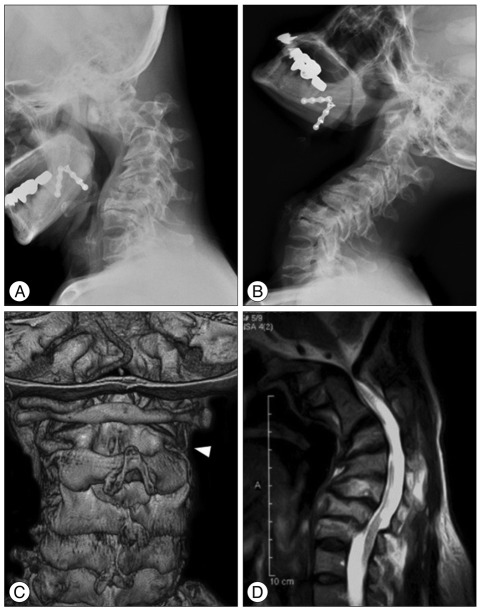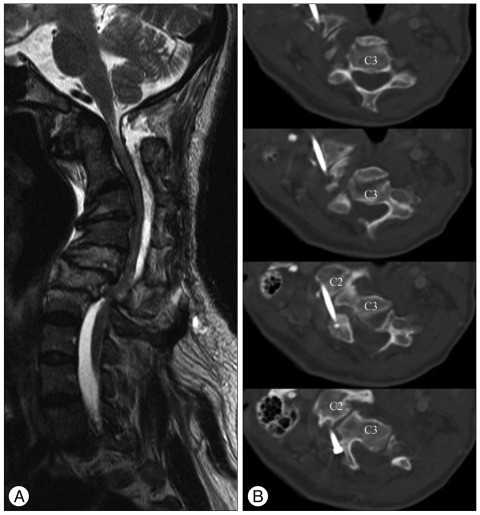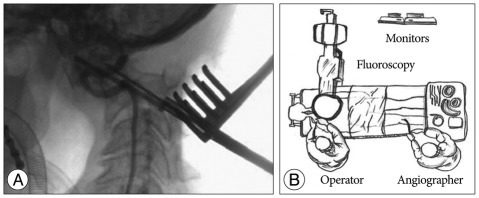J Korean Neurosurg Soc.
2012 Mar;51(3):177-181. 10.3340/jkns.2012.51.3.177.
Intraoperative Vertebral Artery Angiography to Guide C1-2 Transarticular Screw Fixation in a Patient with Athetoid Cerebral Palsy
- Affiliations
-
- 1Department of Neurosurgery, Eulji University Hospital, Daejeon, Korea. twoboss21@naver.com
- 2Department of Neurosurgery, Konyang University Hospital, Daejeon, Korea.
- KMID: 2018196
- DOI: http://doi.org/10.3340/jkns.2012.51.3.177
Abstract
- We present a case of an athetoid cerebral palsy with quadriparesis caused by kyphotic deformity of the cervical spine, severe spinal stenosis at the cervicomedullary junction, and atlantoaxial instability. The patient improved after the first surgery, which included a C1 total laminectomy and C-arm guided righ side unilateral C1-2 transarticular screw fixation. C1-2 fixation was not performed on the other side because of an aberrant and dominant vertebral artery (VA). Eight months after the first operation, the patient required revision surgery for persistent neck pain and screw malposition. We used intraoperative VA angiography with simultaneous fluoroscopy for precise image guidance during bilateral C1-2 transarticular screw fixation. Intraoperative VA angiography allowed the accurate insertion of screws, and can therefore be used to avoid VA injury during C1-2 transarticular screw fixation in comorbid patients with atlantoaxial deformities.
Keyword
MeSH Terms
Figure
Reference
-
1. Azuma S, Seichi A, Ohnishi I, Kawaguchi H, Kitagawa T, Nakamura K. Long-term results of operative treatment for cervical spondylotic myelopathy in patients with athetoid cerebral palsy : an over 10-year follow-up study. Spine (Phila Pa 1976). 2002; 27:943–948. discussion 948. PMID: 11979166.
Article2. Duan S, He H, Lv S, Chen L. Three-dimensional CT study on the anatomy of vertebral artery at atlantoaxial and intracranial segment. Surg Radiol Anat. 2010; 32:39–44. PMID: 19707709.
Article3. Duruflé A, Pétrilli S, Le Guiet JL, Brassier G, Nicolas B, Le Tallec H, et al. Cervical spondylotic myelopathy in athetoid cerebral palsy patients : about five cases. Joint Bone Spine. 2005; 72:270–274. PMID: 15851002.
Article4. Haid RW Jr. C1-C2 transarticular screw fixation : technical aspects. Neurosurgery. 2001; 49:71–74. PMID: 11440462.
Article5. Haro H, Komori H, Okawa A, Shinomiya K. Surgical treatment of cervical spondylotic myelopathy associated with athetoid cerebral palsy. J Orthop Sci. 2002; 7:629–636. PMID: 12486465.
Article6. Hirose G, Kadoya S. Cervical spondylotic radiculo-myelopathy in patients with athetoid-dystonic cerebral palsy : clinical evaluation and surgical treatment. J Neurol Neurosurg Psychiatry. 1984; 47:775–780. PMID: 6470718.
Article7. Hue YH, Chun HJ, Yi HJ, Oh SH, Oh SJ, Ko Y. Unilateral posterior atlantoaxial transarticular screw fixation in patients with atlantoaxial instability : comparison with bilateral method. J Korean Neurosurg Soc. 2009; 45:164–168. PMID: 19352478.
Article8. Kawaguchi Y, Ishihara H, Ohmori K, Kanamori M, Kimura T. Computer-assisted Magerl's transarticular screw fixation for atlantoaxial subluxation. J Orthop Sci. 2002; 7:131–136. PMID: 11819145.
Article9. Laherty RW, Kahler RJ, Walker DG, Tomlinson FH. Stereotactic atlantoaxial transarticular screw fixation. J Clin Neurosci. 2005; 12:62–65. PMID: 15639416.
Article10. Lang SS, Eskioglu E, A Mericle R. Intraoperative angiography for neurovascular disease in the prone or three-quarter prone position. Surg Neurol. 2006; 65:283–289. discussion 289. PMID: 16488250.
Article11. Madawi AA, Casey AT, Solanki GA, Tuite G, Veres R, Crockard HA. Radiological and anatomical evaluation of the atlantoaxial transarticular screw fixation technique. J Neurosurg. 1997; 86:961–968. PMID: 9171174.
Article12. Mihara F, Yoshiura T, Noguchi T, Togao O, Morioka T, Sasaki T, et al. A method to reduce saline and heparin in intraoperative cerebral angiography : a preliminary report. Radiat Med. 2005; 23:588–589. PMID: 16555571.13. Neo M, Matsushita M, Yasuda T, Sakamoto T, Nakamura T. Use of an aiming device in posterior atlantoaxial transarticular screw fixation. Technical note. J Neurosurg. 2002; 97:123–127. PMID: 12120635.
Article14. Onari K, Kondo S, Mihara H, Iwamura Y. Combined anterior-posterior fusion for cervical spondylotic myelopathy in patients with athetoid cerebral palsy. J Neurosurg. 2002; 97:13–19. PMID: 12120637.
Article15. Richter M, Mattes T, Cakir B. Computer-assisted posterior instrumentation of the cervical and cervico-thoracic spine. Eur Spine J. 2004; 13:50–59. PMID: 14634850.
Article16. Schievink WI, Vishteh AG, McDougall CG, Spetzler RF. Intraoperative spinal angiography. J Neurosurg. 1999; 90:48–51. PMID: 10413125.
Article17. Song GS, Theodore N, Dickman CA, Sonntag VK. Unilateral posterior atlantoaxial transarticular screw fixation. J Neurosurg. 1997; 87:851–855. PMID: 9384394.
Article18. Tokuda K, Miyasaka K, Abe H, Abe S, Takei H, Sugimoto S, et al. Anomalous atlantoaxial portions of vertebral and posterior inferior cerebellar arteries. Neuroradiology. 1985; 27:410–413. PMID: 4058734.
Article19. Tsirikos AI, Chang WN, Shah SA, Miller F. Acquired atlantoaxial instability in children with spastic cerebral palsy. J Pediatr Orthop. 2003; 23:335–341. PMID: 12724596.
Article20. Wright NM, Lauryssen C. Vertebral artery injury in C1-2 transarticular screw fixation : results of a survey of the AANS/CNS section on disorders of the spine and peripheral nerves. American Association of Neurological Surgeons/Congress of Neurological Surgeons. J Neurosurg. 1998; 88:634–640. PMID: 9525707.
Article21. Yamazaki M, Koda M, Aramomi MA, Hashimoto M, Masaki Y, Okawa A. Anomalous vertebral artery at the extraosseous and intraosseous regions of the craniovertebral junction : analysis by three-dimensional computed tomography angiography. Spine (Phila Pa 1976). 2005; 30:2452–2457. PMID: 16261125.
Article
- Full Text Links
- Actions
-
Cited
- CITED
-
- Close
- Share
- Similar articles
-
- C1/2 Transarticular Screw Fixation for Complicated Os Odontoideum: Case Report
- Clinical and Biomechanical Analysis of Transarticular Screw Fixation for Atlantoaxial Instability
- Transarticular Screw Fixation in Atlantoaxial Instability
- The Results and Complications of the C1-C2 Transarticular Screw Fixation Methods
- Atlantoaxial Fixation using Rod and Screw for Bilateral High-riding Vertebral Artery





